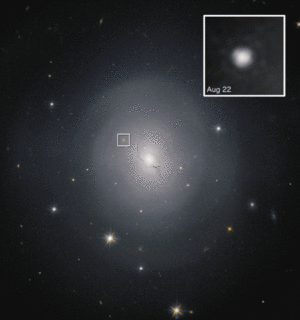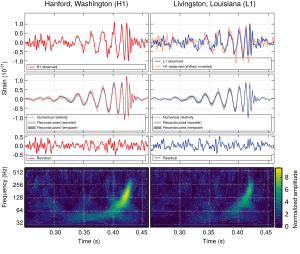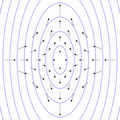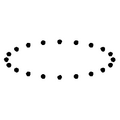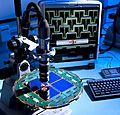Gravitational wave facts for kids
Gravitational waves are like ripples or waves in the fabric of space and time. They are made when very heavy objects move around quickly. Imagine dropping a stone into a pond; it makes ripples. Gravitational waves are similar, but they happen in space itself!
The famous scientist Albert Einstein first thought of these waves in 1916. He described them in his theory called general relativity. For a long time, they were just a prediction. But on September 14, 2015, scientists finally detected them directly for the first time!
To make strong gravitational waves, something incredibly massive has to speed up very, very fast. The best sources are systems with two stars orbiting each other. These can be white dwarfs, neutron stars, or even black holes.
Contents
What are Gravitational Waves?
In physics, gravitational waves are tiny ripples in the way space and time bend. They spread out from where they are made, like waves from a stone in water. Albert Einstein predicted them over 100 years ago. His theory of general relativity said these waves carry energy as "gravitational radiation."
Gravitational waves cannot travel faster than the speed of light. This is a key part of Einstein's theory. Before they were found, some older ideas about gravity said interactions could happen instantly. But finding gravitational waves proved Einstein's ideas were right.
In 1993, a Nobel Prize in Physics was given out. It was for studying a binary star system called Hulse-Taylor. The way these stars moved suggested that gravitational waves were real, not just a math idea.
How Do We Find Gravitational Waves?
To find these tiny ripples, scientists use special detectors. These detectors are built to be super sensitive. They can pick up the smallest changes in space caused by a passing wave.
Weber Bars: Early Detectors
One of the first ideas for a detector was called a Weber bar. This was a large, solid bar of metal. It was kept very still, away from other vibrations. The idea was that a gravitational wave would make the bar vibrate a tiny bit.
Joseph Weber claimed to have found daily signals using his bar. But other scientists, Richard Garwin and David Douglass, disagreed with his results. Modern Weber bars are still used. They are kept super cold and use special devices to find tiny vibrations. However, they are not sensitive enough for most gravitational waves.
One modern Weber bar is called MiniGRAIL. It's a huge, round sphere of metal at Leiden University. It weighs 1,150 kilograms (about 2,500 pounds)! Being round helps it detect waves from any direction. MiniGRAIL is good at finding waves from spinning neutron stars or small black holes merging.
Interferometers: Super Sensitive Detectors
A much more sensitive way to find gravitational waves uses lasers. These detectors are called interferometers. They measure tiny changes in distance between two separated objects. This allows them to be very large, which helps them find bigger signals. They can also detect a wide range of wave frequencies.
The first ground-based interferometers started working in 2015. The most sensitive one is called LIGO. LIGO stands for Laser Interferometer Gravitational-Wave Observatory. It has three detectors. Two are in the United States, in Livingston, Louisiana and Hanford, Washington. A third one is planned for India.
Each LIGO observatory has two long arms, 4 kilometers (about 2.5 miles) long. These arms are at a 90-degree angle to each other. Lasers shine down these arms through vacuum tubes. When a gravitational wave passes, it stretches one arm slightly while shortening the other. This tiny change is exactly what the interferometer is designed to measure.
Even the strongest gravitational waves only change the arm length by an incredibly small amount. We are talking about 10−18 meters! That's much smaller than an atom. Scientists are always working to make these detectors even more sensitive. Another sensitive interferometer, KAGRA, started operating in Japan in 2020.
Interferometers face challenges like "shot noise" from lasers and "thermal noise" from heat. Also, ground vibrations like earthquakes or even lightning can cause noise. Scientists have to carefully filter out all this noise to find real gravitational wave signals.
Einstein@Home: Citizen Science
Some gravitational waves have a constant frequency, like a pure musical note. These could come from a spinning neutron star that isn't perfectly round. These signals don't change much in strength or frequency. However, the Earth's movement causes a slight Doppler shift in the signal.
Finding these signals takes a lot of computer power. This is because scientists have to look through huge amounts of data. The Einstein@Home project helps with this. It's a distributed computing project, like SETI@home. Volunteers let their home computers help analyze data from LIGO and other detectors. This allows scientists to search through data much faster.
Space-Based Detectors
Scientists are also planning to build interferometers in space. One such project is called LISA. LISA would have three spacecraft forming a huge triangle. Lasers would connect them, creating two independent interferometers.
LISA is planned to orbit the Sun, following behind Earth. Each arm of its triangle would be five million kilometers long! Being in space means it would be in a perfect vacuum. This helps avoid noise from Earth. However, it would still face challenges from heat, laser noise, and cosmic rays.
Amazing Discoveries by LIGO and Virgo
On February 11, 2016, the LIGO team announced a huge discovery. They had made the first observation of gravitational waves! The signal was detected on September 14, 2015. It came from two black holes merging together. These black holes were about 29 and 36 times the mass of our Sun. They merged about 1.3 billion light-years away!
In the last tiny fraction of a second of the merger, it released an incredible amount of energy. It was more than 50 times the power of all the stars in the entire observable universe combined! The new black hole formed was 62 times the Sun's mass. The missing mass (three solar masses) was turned into gravitational waves.
Both LIGO detectors saw the signal. There was a 7-millisecond difference in time between the two detections. This helped scientists figure out where the signal came from. It came from the southern part of the sky. This discovery was a huge step for science.
Since then, LIGO and another detector called Virgo have found many more gravitational waves. Most of these have been from black holes merging.
On October 16, 2017, LIGO and Virgo announced another amazing find. They detected gravitational waves from two neutron stars crashing into each other! This event happened on August 17, 2017. Scientists could figure out the mass of these neutron stars.
What made this event even more special was that it also produced light! A gamma-ray burst was detected just 1.7 seconds after the gravitational waves. This light signal came from near the galaxy NGC 4993. Many telescopes around the world then looked at this spot. They saw a "kilonova," which is a huge explosion of light. This confirmed that neutron star mergers create both gravitational waves and light.
In 2021, scientists announced the first detections of neutron stars merging with black holes. These events had never been seen before using regular telescopes. Gravitational wave detectors are opening up a whole new way to explore the universe!
Images for kids
-
Two-dimensional representation of gravitational waves generated by two neutron stars orbiting each other.
-
Early evidence that seemed to show gravitational waves from the Big Bang was found by the BICEP2 radio telescope. This picture shows a close-up of the BICEP2 detector. However, in 2015, it was confirmed that these findings were actually caused by cosmic dust.
See also
 In Spanish: Onda gravitatoria para niños
In Spanish: Onda gravitatoria para niños


